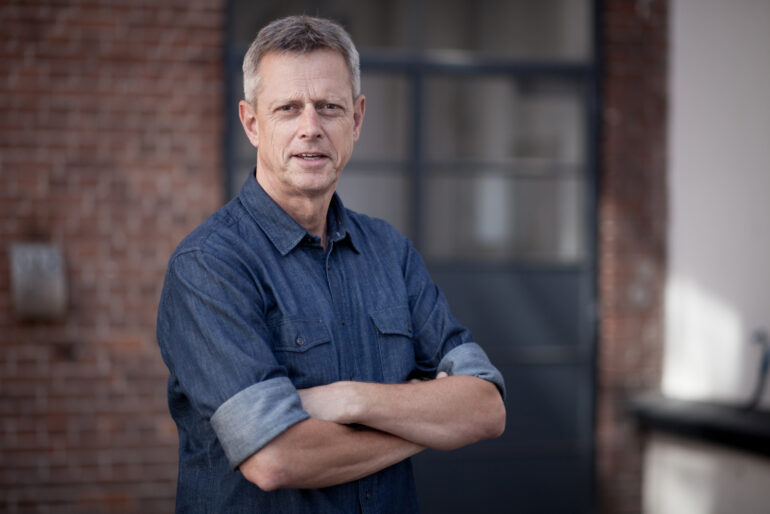WRITTEN BY: Per Juul Carlsen
After 18 years at the top of the Danish Film Institute, Claus Ladegaard steps down. We asked him about his major concerns in times when the film companies are struggling to survive.
“Odin”. That’s the nickname the directors of the film institutes in Norway, Finland and Sweden gave Claus Ladegaard, their Danish colleague. At least that’s what Norway’s Kjersti Mo told the amused crowd when Ladegaard held his farewell reception at the Danish Film Institute in August. Not only is Ladegaard taller and older than the directors from the other Nordic countries; he always has an answer to all the problems, Mo said.
She was right. After 11 years as head of film funding and 7 as CEO, Ladegaard leaves the Danish Film Institute this January. Neither “Odin” nor Huginn and Muninn, the wise ravens on his shoulders, will retire. Consultant jobs and boards, amongst others, are ahead. And when asked what advice the head of the Nordic Gods will be handing to his successor, Tine Fischer, and the rest of the Nordic film business, Ladegaard only once says “I have no idea what to do”. That’s when asked the question “How do we make the classic media excited about local films again?”, with regard to the decreasing interest in supporting local films the media show us these days.
Apart from the fact that Ladegaard is indeed a catalogue of confident solutions that could easily ignite debates within a film industry that has always been ready for heated arguments, he states that with a pretty generous support system the funding looks healthy, at least in Denmark. And “in many ways it is up to ourselves or the film industry to take advantage of the opportunities that exist”.
But he’s warning against the unrestrained use of production incentives as a tool to create economic activity - instead of a cultural or artistic approach - which is the basis of film funding in most of Europe. According to Ladegaard, this has led to overproduction and “a lot of films that very few people want to see”, especially in Germany, France and Spain. He’s not a fan of the Norwegian model, with a production discount that aims to attract international productions, but which doesn’t support local films funded by the Norwegian Film Institute. “That’s a wrong way of doing it. Why use public money to fund American films, when you can strengthen domestic films instead? I think it's much more interesting to use production incentives to bring in international funding to Nordic films and series, making them more ambitious, and then make sure that they can shoot at home instead of going abroad.”
Generally, Ladegaard’s focus is on developing a healthy local film industry:
“The film funding schemes are based on the idea that somebody turns up with a manuscript, and then the Film Institutes say yes or no. That’s a narrow way of thinking. If you want strong production companies in small territories like the Nordic countries, the film institutions have to be much more than funding institutions. They have to strengthen the producers' ability to deal with all the other things: financing, rights, business development, inclusion and sustainability. This industry development perspective is extremely important.”
But, as Ladegaard points out, the main concern right now is distribution:
“The big big big challenge in the years to come is the cinemas. Film has actually managed to maintain a financially profitable first window, namely the cinemas. It's extremely important for film that this is something we do for the cinemas.”
And it is a challenge. The amount of cinema tickets sold in Denmark in 2024 is down 25 per cent compared to the amount in 2020, and the lowest in 30 years (the COVID-19 years excluded). It's a problem within all the Nordic countries. As Ladegaard points out, the amount of tickets for the cinemas was not affected by the arrival of Netflix from 2012 to 2020, but something has changed after COVID-19. While museums, theatres and music concerts are experiencing record numbers of visitors, and football at the stadiums is bigger than ever in Denmark, something has stagnated in the temples of the film media, the cinemas.
“It may have something to do with how the cinema experience is perceived by the audiences. I think it’s necessary for the cinemas to regain their position.”
When it comes to films, Ladegaard can see two paths ahead.
“There’s clearly an event culture, much illustrated by the success of Barbie and Oppenheimer last summer*.* People go to the cinemas to experience an event. That’s why we need to be much more attentive to making big and ambitious films which offer something cinematic that you cannot find anywhere else. And the other thing I believe is really important, is that you, especially for arthouse films, think: ‘What kind of film is this? What is it that makes an arthouse film indispensable in the cinema?’ And that's where we're challenged in the Nordic countries, because we have an arthouse tradition, an everyday drama tradition, that can easily move to the small screens. A film like the concentration camp drama The Zone of Interest is a great example of a film that uses sound and picture to create something that’s completely different from watching it on a small screen. It’s decisive that arthouse film reclaims the cinematic vibe, or the cinematic language.”
